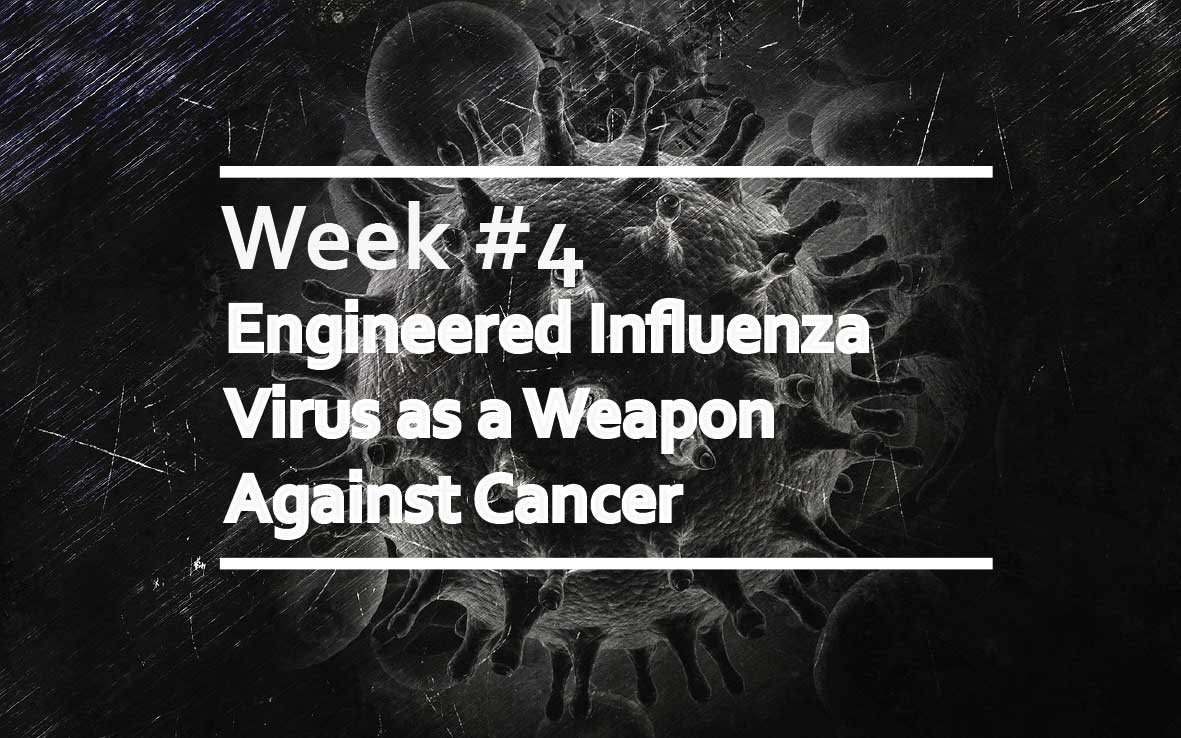Engineered Influenza Virus as a Weapon Against Cancer
What if a virus could be used to selectively replicate in – and kill – cancer cells, without harming the normal tissues? Some researchers are aiming to do exactly this by genetically engineering oncolytic viruses (viruses that preferentially infect and kill cancer cells). Here we share the recent efforts of Hamilton et al. (2018) at the Icahn School of Medicine, New York.
Oncolytic viral therapy exerts its anti-cancer effect by two principle mechanisms: 1) the targeting of the virus to malignant cells is greatly enhanced, usually because cancer cells have lost their protection mechanisms against viral infection, thus enabling viral amplification; and 2) whole-body (systemic) anti-tumor immunity is somehow induced by treatment with the cancer-targeting virus.
Influenza A virus (IAV) is well-suited to being engineered into an oncolytic virus because, as an RNA virus, it is unable to integrate into the host genome. Previous efforts to produce oncolytic influenza viruses have focused on generating IAVs containing deletions in the viral genome that reduce virulence in normal tissues but allow virus replication in mutant cancer cells (mechanism #1, above). Moreover, engineered IAVs have been shown to induce immune responses by activating cytotoxic T-lymphocytes and natural killer cells (mechanism #2, above).
To enhance the anti-cancer properties of oncolytic viruses, so-called armed viruses have been developed. In addition to their naturally occurring oncolytic activities, these viruses carry genes encoding products that exert anti-cancer effects. Hamilton et al. (2018) aimed to generate such an armed oncolytic IAV. To do this, they engineered their IAV to express an immune checkpoint inhibitor; a molecule (in this can an antibody) that can inhibit our natural negative regulators of the immune system (which are involved in maintaining self-tolerance [e.g., preventing autoimmunity]). This is based on the notion that cancer cells use immune checkpoints to protect themselves from the immune system.
Specifically, Hamilton et al. engineered their IAV to express an antibody that antagonizes the immune checkpoint protein cytotoxic T lymphocyte antigen-4 (CTLA4). CTLA-4 is expressed on activated T and B lymphocytes and, upon ligand binding, negatively regulates cell-mediated immune responses.
To test their engineered oncolytic IAV, Hamilton et al. used mice that had been implanted with melanoma cells, a highly aggressive and metastatic model of cancer. Melanoma cells were implanted into both the right and the left rear flanks of mice, but only the right-flank tumors were treated with an injection of their engineered oncolytic IAV (a wild-type IAV was also injected into some mice as a control). Although the wild-type IAV was able to slow the growth of right-flank tumors compared to mice receiving dummy injections (phosphate-buffered saline), the tumors treated with the engineered oncolytic IAV barely grew at all. Moreover, in the mice treated with the oncolytic IAV, even the non-injected left-flank tumors had delayed growth, suggesting that the oncolytic IAV somehow supported a whole-body anti-tumor immune response. Importantly, the oncolytic IAV treatment prolonged the survival of the mice compared to those given the wild-type virus or phosphate-buffered saline.
Although it is not clear how the oncolytic IAV treatment was able to slow tumor growth in the non-injected left-flank tumors, the available evidence suggests that this is not a result of the virus spreading from the right-flank to the non-injected left-flank. Hamilton et al. hypothesize that there could be tumor-specific CD8+ T cells nearby the tumors injected with their the oncolytic IAV, and that expression of the checkpoint inhibitor by the virus-infected tumor cells can increase the cell-killing ability of these CD8+ T cells, thereby providing a whole-body anti-cancer effect.
The work of Hamilton et al. builds on recent preclinical studies addressing the efficacies of oncolytic viruses, some of which are now being tested in clinical trials. It now seems likely that the power of genetic engineering will unlock the promise of oncolytic viruses and every successful outcome brings us closer to harnessing their power.




